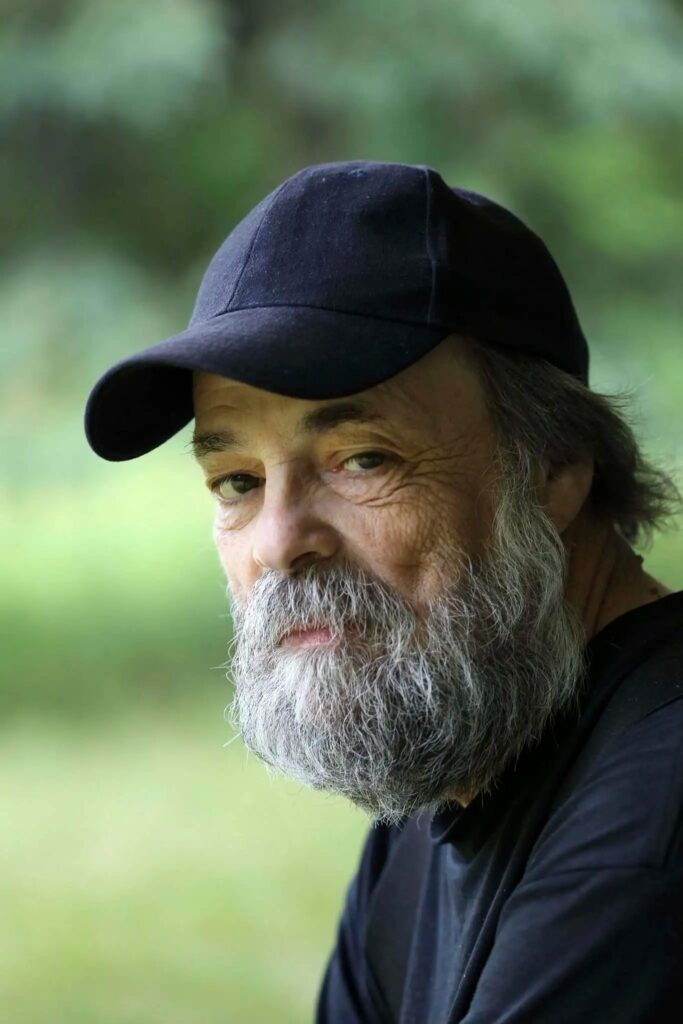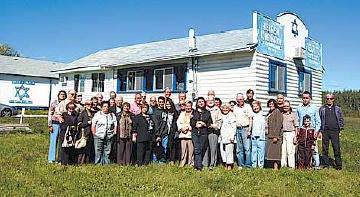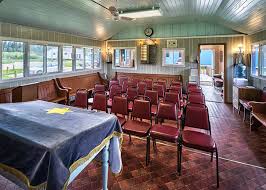Features
Mitch Podolak: ‘A Citizen of Earth’

By KINZEY POSEN (Ed. note: This story first appeared in the October 11, 2017 issue of The Jewish Post & News. With the Annual Winnipeg Folk Festival about to celebrate 50 years since its inception – and which MItch helped create – along with his wife Ava Kobrinsky and Colin Gorrie, we thought it an appropriate time to reprint Kinzey’s moving tribute to Mitch.)
Last November Mitch Podolak was leaving one of his favourite Winnipeg restaurants, the Evergreen on Pembina, when he suddenly fell outside. As he lay there somewhat stunned, he realized that this fall was about to change his life. He couldn’t feel the lower part of his body after landing hard on his neck.
Fast forward to September 2017 and I’m sitting with Mitch in his apartment on Sterling Lyon Parkway in Tuxedo. He just turned 70 on September 21st. When I said, “Imagine, Mitch Podolak living in Tuxedo,” he quickly says, “It’s the wrong side of the tracks.”

In a way I guess he’s right – you can see and hear the rail line close up from his window and Ikea is across the road. He and his wife, Ava Kobrinsky, moved there after he was released from the hospital in April of this year. They still have their home in Wolseley, but Mitch can’t negotiate the stairs and living on one floor is the way to go for now. These days, Mitch uses a motorized wheelchair to get around and his apartment has specialized equipment to help him stand and perform his physiotherapy. He admits he loves the exercise.
Mitch has come a long way from that fateful day last November and can now stand on his own, walk unaided for a short distance, and has regained much of the feeling in his body. There’s still a long way to go to be considered normal, but he’s confident that by the end of this year, he’ll be more mobile.
For those who know him, Mitch’s name is synonymous with the Winnipeg Folk Festival, the Edmonton and Vancouver Folk Festivals, the West End Cultural Centre, The Stan Rogers Festival in Canso, Home Routes… the list goes on. He’s also well known for his political action and work in trying to bring about change. His efforts have led to his being awarded an Honourary Doctorate from Brandon University and the Order of Manitoba from the Province.
When Mitch had to attend the award’s ceremonies, he knew that he had to wear something a bit more sophisticated than his usual black T shirt and jeans. He called up friend and magician Brian Glow to be his fashion consultant. After spending $600 on a dapper black suit, black shirt and silver tie, Mitch shocked many by appearing in his new clothes.
So how did Mitch come to be where he is now, a veritable living legend – a man with more stories to tell than a recovering addict at a 12 step meeting?
It all started in Toronto in 1947, when he was born to Rhoda Layefsky and Noach Podolak. His dad was 20 years older than his mum. Mitch is the youngest of three children – after Alice, the oldest, who lives in Cape Breton, and his brother Mark, a retired Treasury Board Analyst in Ottawa, who’s known as the “white sheep” of the family.
The Podolak family lived on Major Street, in a neighbourhood full of Jews and Europeans located between Bathhurst and Spadina. His father Noach, originally from Poland, was a housepainter, who also did theatrical sets for the Yiddish Theatre in New York for a period of time and was a friend of the well known Jewish actor, Paul Muni. His mum Rhoda was a strong, loving woman, who was born in Canada. Her dad, Mitch’s grandfather Avram Liebe, played a special role in his life and was his hero. The two had a special relationship. During the Spanish Civil War, Rhoda was an organizer for the Friends of the Mackenzie-Papineau Battalion.
Both Mitch’s parents were passionate socialists and he grew up in a rich atmosphere full of fervent political discussions. Mitch’s dad was a member of the Communist Party, but pulled out of the organization in 1956, over the invasion of Hungary and anti-Semitism in the Soviet Union. It was also the year he died, when he was only 56. Mitch was only nine years old at the time and Rhoda, who was now widowed in her thirties, turned her energy to providing for her three kids. She worked as a bookkeeper and remained a widow until her passing in 2005.
At the age of seven, Mitch started to learn how to play the clarinet. The lessons were classical and he really didn’t like it. Although he grew up in an era when rock & roll was making its debut and was just beginning to move the world in a different direction, Mitch was destined to follow a different musical path altogether. When he was 13, his older sister Alice had two tickets to go to a concert at Massey Hall with a guy who was a no-show. Instead, she took Mitch, who thought his sister was going to take him to the symphony. To his surprise, it was to a concert that forever changed his life. The featured performer was folk legend Pete Seeger and young Mitch was simply awestruck, especially by one song. On the way home, Alice explained to him what that particular piece, the “Bells of Rhymney,” was about and what the performer was trying to get across to the audience. He connected with the songs in a way that was new and liberating. Since that day, Mitch has become an ultra passionate supporter and fan of folk music, the kind we call “singer songwriter” now. Along the way, he also learned how to play the banjo quite well.
Mitch comes by his musical ability quite honestly. His uncle Philip on his dad’s side was the conductor of the Polish Army Symphony and his dad, Noach, played the clarinet.
Growing up in a very socialist family, Mitch was sensitive to the actions of the McCarthy era. He recalled two television shows in the fifties that were anti-Communist: “The Man called X” and “I Led Three Lives.” Both seemed to have the communists meeting in basements, with peeling paint and bare wire light bulbs hanging from the ceiling. The plots were often about how to recruit new members and sabotage buildings. On the walls there were portraits of Marx, Lenin, Engels, and Stalin, and they all spoke in bad Russian accents.
As Mitch’s awareness of how socialism could benefit society deepened, he recalled one event that sticks with him till today. It was seeing a hungry man eat chicken out of a garbage can – an image that’s put much into perspective for him.
In 1961, at the age of 14, he joined what was known at the time, as the Y.S.A – the Young Socialist’s Alliance, in Toronto – a Trotskyite youth movement, where everyone called each other “comrade”. Mitch was the youngest member by only a few months. When he first attended a meeting, much like the TV shows, there were portraits on the wall of Marx, Lenin and Engels, but instead of Stalin, there was Leon Trotsky. His involvement gave him the tools and inspiration to engage in socialism and later the anti Viet Nam war movement. Around that time, he met Harry Paine at a movement meeting – a man who would go on to become one of his best friends.
In 1968, Mitch made the move to Winnipeg to study as a mature student at the University of Manitoba and specifically do political organizing. He also established the Vietnam Mobilization Committee. Mitch recalled one particular scene during this period, when he and his friend, Joe Flexer, organized a major event at the U of M. They wanted to go to the Dow Chemical Company’s recruitment centre on campus to demonstrate. At the time, Dow was one of the manufacturers of napalm, a rather nasty incendiary weapon used in Viet Nam against the Viet Cong and innocent people. It would stick to the skin and cause severe burns.
In anticipation, Mitch and Joe went to a hardware store and bought the biggest chains and padlocks they could find to lock the doors to the centre. After entering and insisting they be able to talk to the Human Resources manager, he eventually came out to hear their statement. It was Joe Flexer who yelled out, “Our statement is, get the f_____ off our campus you war-mongering c__k s___s!”
That’s when the situation escalated. The manager went back into the building and the protestors pulled out the lock and chains to stop people from entering and exiting. Soon, there were a thousand people and fights began to break out. As Mitch recalls, it was a crazy time. Mitch recalls that his salary as an organizer was a hundred dollars a month.

In 1970, he left Winnipeg and began to do more political work in Halifax. It was during that time that Mitch first met Winnipegger Ava Kobrinsky, his wife of 40 plus years. They met in 1971 at the Trotskyist Hall in Toronto and were soon married. They returned to Winnipeg in 1972 when Mitch was 24.
Two years later, Mitch co-founded the Winnipeg Folk Festival with Ava and Colin Gorrie and his life took on a completely different dimension. Over the years, his expertise and vision helped establish almost all of the major folk festivals throughout Western Canada, plus others in Ontario and the Maritimes. He was a bona fide Folk Festival consultant.
As we talked, the subject shifted to music and Mitch showed me how he couldn’t use his left hand any more to play the banjo. Some of the fingers had lost their feeling and were also muscle damaged. He used his electric wheelchair to move over to his desk and grabbed a harmonica. He blew a few fat notes and told the story of how he came to play.
One night, while still in the hospital, at around 10:30 pm Mitch was in bed. He was startled to hear a familiar voice asking people outside his room, “Where’s Mitch?” when suddenly, well known blues musician, Big Dave McLean barged in.He handed him a harmonica and in his gruff voice said, “Here, learn how to play it,” and quickly left.
His multi-month experience in the Health Sciences Centre taught him several things. He can’t say enough about the doctors, nurses and staff who touched him through their professionalism, dedication and caring. He reflects a lot about what will happen with the impending cutbacks and what will happen when more baby boomers enter the system.
Back in January, Mitch’s good friend , singer, songwriter, and artist, Heather Bishop, organized a crowdfunding initiative to help finance necessary renovations to his home. It’ll allow him to live there eventually.
The goal was $20,000. It went live on Thursday and by Friday, the goal had been reached. Mitch was deeply touched by the outpouring of good wishes, stories and funds. It’s something he’ll never forget.
I asked Mitch if he had any regrets so far in his 70 years and his response was an immediate: “None.” I then asked what he was most proud of and he said, “The work we did to help stop the war in Vietnam, the West End Cultural Centre,” and, he added, the numerous folk festivals he established. Then, pausing for a few seconds, he smiled in his chair and said,“I’m proud of my relationship with my wife, our partnership, and my children.”
“Ava is an unsung hero, brilliant at organization, without her, none of this would have happened,” he added.
It’s not difficult to see what drives Mitch Podolak in terms of inspiration.
Basically, it’s two things: politics and music – in no particular order. It’s where it started for him and where he continues to flourish and contribute as a human being.
Mitch is constantly thinking of where to go next. His medical problems as a human being have given him plenty of time for introspection and he wards off any negativity by staying focused on his projects. His body may have slowed down, but his brain doesn’t rest.. The power of a moving lyric tied to a melody never fails to move him. Pair that with his love of freedom, justice and “menshlechkeit,” and you realize that what his family inculcated him is ever present.
He has three major projects he’s working on right now. One of them is a book entitled “Passing Through.” It will consist of 71 essays of people he has known throughout his life, including: his Uncle Meyer, who jumped off
the train on the way to Auschwitz, but whose family refused to follow him; his Zeida Avram Leibe – his mum’s dad whom he idolized and who taught him how to play gin; plus Mitch’s very close friends, Joe Flexer and Harry Paine, among 67 others.
Throughout the years, Mitch has kept in touch with his siblings, cousins, nephews and nieces. He appreciates family and the connections it brings. He calls it the core Podolak: people caring about other people.
I ended our conversation by asking Mitch how he feels about being a Jew. His Hebrew name is Melech which, of course, means king – and he likes the name. His mum Rhoda often used it: “Melech Ben Noach”, a.k.a. Mitch Podolak. Suffice to say, you’re not going to find Melech at any of the synagogues on Yom Kippur or on any other holidays. He loves the culture, the food, the music, the humour, but he’s an avowed atheist. He’s well aware of Jewish values and ethics and uses them to form his vision of a better world, especially the aspects of brotherhood and sisterhood. When it comes to Israel, Mitch has hopes of it becoming a socialist country, in the context of a socialist Middle East in which all Semites are equal and united in making a better world. In his way, Mitch Podolak has found a path to peace.
At the age of 70 and having to undergo a traumatic health setback, he’s remarkably selfless, stubborn, surprisingly traditional, and ever hopeful and optimistic. In fact, these days, at a time when his injuries won’t allow him to play his beloved banjo, Mitch says, “At least I can sing badly!”
(Ed. note: MItch Podolak passed away in August 2019.)

Features
Japanese Straightening/Hair Rebonding at SETS on Corydon

Japanese Straightening is a hair straightening process invented in Japan that has swept America.

Features
History of the Winnipeg Beach Synagogue: 1950-2025

By BERNIE BELLAN The history of the Winnipeg Beach Synagogue is a fascinating one. We have had several articles over the years about the synagogue in The Jewish Post & News.


In June 2010 I wrote an article for The Jewish Post & News upon the 60th anniversary of the synagogue’s opening. Here are the opening paragraphs from that article:
“Sixty years ago a group of Winnipeg Beach vacationers decided that what their vacation area lacked was a synagogue. As it happened, a log cabin one-room schoolhouse in the Beausejour area happened to be available.
“In due course, the log cabin was relocated to the corner of Hazel and Grove in Winnipeg Beach, where it stayed for 48 years.”

In December 1994 my late brother, Matt, wrote a story about the spraying of antisemitic grafitti on the synagogue which, at that time, was still situated at its original location on the corner of Hazel and Grove in the town of Winnipeg Beach:
“Two 16-year-olds spraypainted slogans like ‘Die Jews,’ ‘I’ll kill you Jews,’ and other grafitti in big letters on the beach synagogue.
“Jim Mosher, a news reporter for the Interlake Spectator in Gimli, said last Halloween’s vandalism against the synagogue wasn’t the first. In the late 1980s, he claimed, it was spraypainted with swastikas.
“Jack Markson, a longtime member of the Winnipeg Beach Synagogue, last week also said he could remember finding anti-Semitic grafitti spraypainted on the synagogue ‘a few years ago,’ and at least twice in the 1970s, when the cottage season was over.”

My 2010 article continued: “In 1998 the Town of Winnipeg Beach informed the members of the synagogue that the building would have to be hooked up to the town’s sewer and water system. Rather than incur the cost of $3-4,000, which was thought to be ‘prohibitive,’ according to longtime beach synagogue attendee Laurie Mainster, synagogue goers looked elsewhere for a solution.
“As a result, the board of Camp Massad was approached and asked whether the synagogue might be relocated there, with the understanding that the synagogue would be made available to the camp at any time other than what were then Friday evening and Saturday morning services.
“Over the years the ‘beach synagogue’ had come to be a very popular meeting place for summertime residents of Winnipeg Beach and Gimli. In fact, for years minyans were held twice daily, in addition to regular Saturday morning services. Of course, in those years Winnipeg Beach was also home to a kosher butcher shop.
“While the little synagogue, which measured only 18 x 24 feet, has gone through several transformations, including the move to Camp Massad, and the opening up to egalitarian services in 2007 (The move to egalitarian services was as much a practical necessity as it was a nod to the equality of women – the only Kohen present at the time was a woman!), it has always remained cramped at the best of times.

“In recent years the synagogue has seen the addition of a window airconditioner (although to benefit from it, you really have to be sitting just a few feet away), as well as a fridge that allows synagogue attendees to enjoy a regular Saturday morning Kiddush meal following the service.
“According to Laurie Mainster, the Saturday morning service has continued to be popular, even though many of the attendees now drive in from Winnipeg, as they have sold the cottages they once maintained.
“On the other hand, one of the side benefits to being located on Camp Massad’s grounds has been an infusion of young blood from among the camp counsellors.
“Since there is no longer a rabbi available to conduct services (Rabbi Weizman did lead services for years while he had a cottage at the beach), those in attendance now take turns leading the services themselves.
“Anyone may attend services and, while there are no dues collected, donations are welcome. (Donations should be made to the Jewish Foundation of Manitoba, with donors asked to specify that their donations are to be directed to the beach synagogue.)
“Mainster also says that the beach synagogue is now undergoing an expansion, which will be its first in 60 years. An entirely new space measuring 16 x 18 feet is being added – one that will allow for a real Kiddush area. (Until now, a table has been set up in the back of the synagogue and synagogue goers would help themselves to the buffet that is set up each Saturday during the summer. While pleasant enough, it will certainly be more comfortable to have an actual area set aside for the Saturday afternoon after service lunch.)
“As for dress, longtime attendee Abe Borzykowski (in an article written by Sharon Chisvin for the Free Press in 2007) remarked that ‘I don’t think there are many synagogues where people can attend in shorts, T-shirts and sandals and not feel out of place.’ “

As mentioned in that 2010 article, the beach synagogue at that time was about to undergo an extensive remodelling. Here is an article from a January 2011 issue that describes that remodelling process. The article was written by Bernie Sucharov, who has been a longtime member of the beach synagogue:
“The Hebrew Congregation of Winnipeg Beach made a major change to the synagogue this past summer. With the help of many volunteers, Joel Margolese being the project manager, the synagogue was expanded and an addition was built to handle the overflow crowds, as well as to add more space for the kiddush following services.
“The volunteers spent many Sundays during the summer months building the addition. Bad weather caused many delays, but finally the addition was completed one week before the official summer opening.
“The volunteers were: Joel Margolese, Gordon Steindel, Sheldon Koslovsky, Viktor Lewin, Harvey Zabenskie, Nestor Wowryk, Kevin Wowryk, Victor Spigelman, Jerry Pritchard, and David Bloomfield.
“On Sunday, June 25, 2010 a special ceremony was held to affix a mezzuzah to the front entrance door. Gordon Steindel had the honour of affixing the mezzuzah, which was donated by Sid Bercovich and Clarice Silver.
“Refreshments and food for the day were prepared by Phyllis Spigelman, also known as our catering manager. Throughout the summer, Phyllis, Lenore Kagan and other friends prepared the food for our kiddush.
“A sound system was donated by Arch and Brenda Honigman in memory of their father, Sam Honigman z”l. “The system was installed by Joel Margolese and Stevan Sucharov. This will allow the overflow crowd to hear the service in the new addition.
“There were also generous donations of 50 chumashim and an air conditioner. The chumashim were donated by Gwen, Sheldon and Mark Koslovsky. The air conditioner in the new addition was donated by Joel and Linda Margolese.
“The official opening of the synagogue for the summer took place on July 3, 2010. We had an overflow crowd of 70+ people.”

Since that 2010 major addition to the synagogue, it has also added a wheelchair ramp (although I’ve been unable to ascertain exactly when the ramp was built). Also, the synagogue also has its own outdoor privy now. (Attendees used to have to use facilities in Camp Massad.)
And, as already noted in article previously posted to this site (and which you can read at Beach Synagogue about to celebrate 75th anniversary), in recognition of that occasion, on August 2nd members of the synagogue will be holding a 75th anniversary celebration.
As part of the celebration anyone who is a descendant or relative of any of the original members of the first executive committee is invited to attend the synagogue that morning.
If you are a relative please contact Abe Borzykowski at wpgbeachshule@shaw.ca or aborzykowski@shaw.ca to let Abe know you might be attending.
Features
Kinzey Posen: CBC Winnipeg’s former “go-to guy”

By GERRY POSNER If former Winnipegger Lawrence Wall was the CBC go-to guy in Ottawa, CBC Winnipeg had its own version of a go-to guy for many years with none other than the very well known Kinzey Posen. Of course, many readers will recognize that name from his career with Finjan, the Klezmer group so famous across Canada and beyond. It has been written about Posen and his wife Shayla Fink that they have been involved in music since they got out of diapers. And, as an aside, their love and ability in music has now been transmitted to the next generation as in their son, Ariel Posen (but that’s another story).
Kinzey Posen (not to be confused with Posner, or maybe we are to be confused, but who knows for sure?), was a graduate of Peretz School, having attended there from nursery right until Grade 7, graduating in1966. That was followed by Edmund Partridge and West Kildonan Collegiate. Musically, he was in large part self taught. However, he did have some teachers along the way. After moving to Vancouver – from 1974-78, he had the chance to study acoustic classical bass with a member of the Vancouver Symphony Orchestra. When Kinzey lived in Vancouver, he also worked as a jazz musician.
Upon returning to Winnipeg, Kinzey enrolled as a mature student at the University of Winnipeg, where he obtained a Bachelor of Urban Studies degree. Although the degree was in no way connected to the career that followed, his attending the University of Winnipeg was critical to his connecting with the CBC. Why? you ask. Kinzey had a position after graduation working for the Institute of Urban Studies. While there, he met someone who invited him to work for the Department of Continuing Education as one of their program directors. At the time the Department of Continuing Education was located at 491 Portage Avenue, which was also known as the TJ Rice Building. The CBC also leased some space in the same building. According to Kinzey, the CBC part of the building “included HR, different shows and other support offices. Continuing Education was located in the basement and main floor and that’s where I worked.”
KInzey had long had an interest in the CBC, which made the fact that the CBC had some offices in the same building where he was working serendipitous. That Kinzey might be interested in visiting the CBC was not an accident. As a young boy he had a nightly connection to CBC, as it was his ritual to listen to CBC Radio (as well as all sorts of other radio stations across the USA) on his transistor radio every night in bed. He became enamoured of one particular CBC host, Bill Guest, so that when going to sleep, he imagined that he was Guest doing interviews with imaginary guests. That dream of working for CBC became a reality when he had a chance to do a one week gig with Jack Farr’s network program.
Kinzey took a week off from his Continuing Education job and spent five days at the CBC. That week was a training session for Posen, as he had to create ideas, research, pre-interview, write the script, and set up the studio for Farr’s interview. He was almost in his dream job – although not quite – since it was only for one week. His opportunity, however, came in 1988, when he was offered a one-year term as a production assistant – the lowest guy on the ladder, for a show called “ Simply Folk,” with the late Mitch Podolak as the host. Although he was indeed at the bottom as far as those working on the show were concerned, he took a chance and gave his notice to the U of W. The rest is history. In his new job, Kinzey learned how to become a producer. Lucky for him, at the end of the year, when the person he replaced was supposed to come back, she never returned (just like the song, “MTA,” by the Kingston Trio). At that point, Kinzey was hired full time at the CBC.
Kinzey was a fixture at the CBC for 27 years. During those years, Kinzey had the chance to work with Ross Porter, a respected former CBC host and producer, also with Karen Sanders – on the “Afternoon Edition.” One aspect of Kinzey’s job on the Afternoon Edition was to come up with ideas, mix sound effects, arrange interviews and music, to create a two-hour radio experience. In addition, he covered jazz and folk festivals and, as a result, was exposed to some of the best musicians in the world. With Ross Porter in the 1990s, he worked on a network jazz show called “ After Hours,” which was on from 8-10 PM five nights a week. Kinzey was involved with writing the scripts, picking the music, and recording the shows, as well as editing them and then presenting them to the network for playback.
Of course, over his career, Kinzey had many memorable moments. He told me about one of them. The story revolved around the National Jazz Awards one year in particular. The awards were to be broadcasted after the National News which, in those days, began much earlier in the evening, and were over by 8:00 pm. The legendary Oscar Peterson was lined up to play a half hour set at the awards, starting at 7:30. But, as Kinzey told me, Oscar Peterson had a “hate on” for the CBC ecause one of his recorded performances was wrongly edited and he refused to appear on CBC under any circumstances. As the time neared 8:05 PM, which was when the CBC was to begin its broadcast of the jazz awards, it became apparent that Oscar was not going to finish on time. As the producer of the awards show, Kinzey was tasked with telling Oscar Peterson to wrap it up and get off the stage. There was Kinzey Posen, a huge fan of Oscar Peterson, now faced with the prospect of telling Oscar – while he was still playing – with 500 people in the audience, to stop and get off the stage. Not often was or is Kinzey Posen frozen, but that was one such moment. There was one loud “Baruch Hashem” from Kinzey when Oscar completed his set literally just in time.
Clearly, Kinzey was part of a very successful run with After Hours as it was on the air for 14 years. It was easily one of the most popular shows on CBC Radio 2, and a winner of several broadcasting awards. Kinzey also played a major role in producing a two part documentary about legendary guitarist Lenny Breau.
When After Hours ended, Posen became one of the contributing producers to Canada Live and specialized in producing live radio specials for the network, such as the Junos, for CBC Radio One and Two. Needless to say, his career planted Posen in the world of some top notch musicians, including his time spent working with Robert Plant (Led Zeppelin), Dave Brubeck, Randy Bachman, Chantal Kreviazuk and a list of prominent names in the Canadian, American and European music spheres. Locally, the CBC came to refer to Kinzey as the Jewish expert. I would add music expert to that title.
After his 27 year run at the CBC – and before he fully retired, Kinzey went on to work for the Rady JCC as a program director for a year and a half. Of course, to say that Kinzey Posen is retired is a major contradiction in terms. You really can’t keep him down and he has his hand in a variety of programs and projects – most of which he remains silent about, as is his style.
When I realized the full depth and talent of Kinzey Posen, I quickly concluded that he must certainly be related to me. Even if he isn’t, I now tell people he is.
